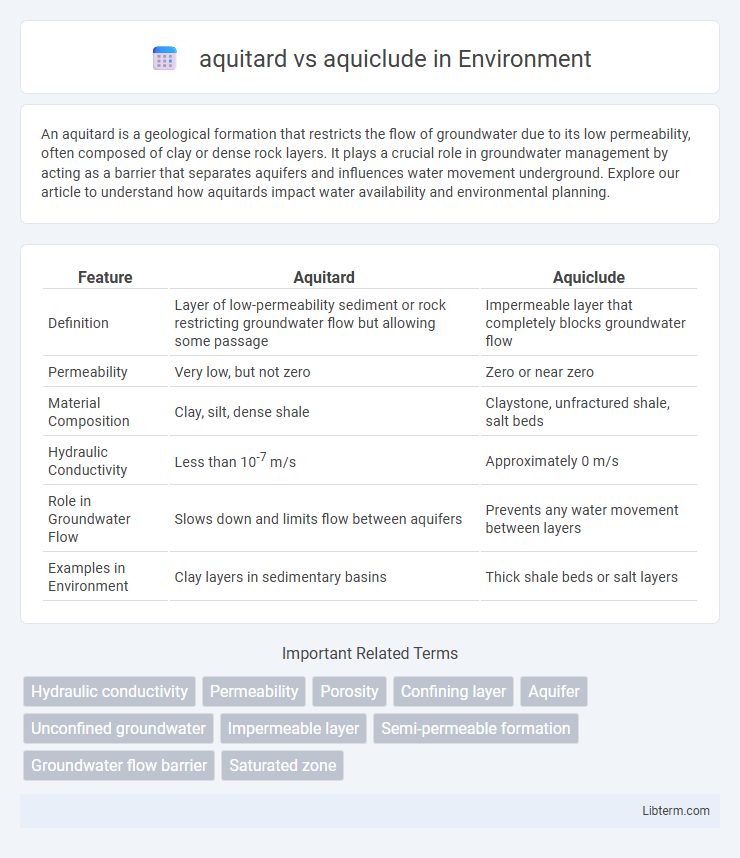An aquitard is a geological formation that restricts the flow of groundwater due to its low permeability, often composed of clay or dense rock layers. It plays a crucial role in groundwater management by acting as a barrier that separates aquifers and influences water movement underground. Explore our article to understand how aquitards impact water availability and environmental planning.
Table of Comparison
| Feature | Aquitard | Aquiclude |
|---|---|---|
| Definition | Layer of low-permeability sediment or rock restricting groundwater flow but allowing some passage | Impermeable layer that completely blocks groundwater flow |
| Permeability | Very low, but not zero | Zero or near zero |
| Material Composition | Clay, silt, dense shale | Claystone, unfractured shale, salt beds |
| Hydraulic Conductivity | Less than 10-7 m/s | Approximately 0 m/s |
| Role in Groundwater Flow | Slows down and limits flow between aquifers | Prevents any water movement between layers |
| Examples in Environment | Clay layers in sedimentary basins | Thick shale beds or salt layers |
Introduction to Aquitards and Aquicludes
Aquitards and aquicludes are geological formations that influence groundwater movement by acting as barriers with varying permeability. Aquitards have low permeability, allowing limited water flow, while aquicludes are essentially impermeable layers that prevent water passage altogether. Understanding the differences between aquitards and aquicludes is crucial for hydrogeology, groundwater management, and contamination studies.
Key Differences Between Aquitards and Aquicludes
Aquitards and aquicludes differ primarily in their permeability and ability to transmit groundwater; aquitards have low permeability restricting water flow while allowing some transmission, whereas aquicludes are impermeable layers that completely prevent water passage. Aquitards often consist of materials like clay or silt that slow down groundwater movement, contrasting with aquicludes composed of dense, non-porous materials such as shale or unfractured rock. The distinction impacts groundwater flow modeling and aquifer recharge, where aquitards act as semi-barriers and aquicludes serve as absolute barriers in hydrogeological systems.
Geological Composition of Aquitards
Aquitards are geological formations composed primarily of semi-permeable materials such as clay, silt, and shale, which slow down but do not completely stop the flow of groundwater. These fine-grained sediments create low hydraulic conductivity zones that restrict water movement while still allowing minimal seepage. In contrast, aquicludes consist of impermeable layers like dense rock or compacted clay that virtually prevent any groundwater flow.
Geological Composition of Aquicludes
Aquicludes consist primarily of dense, unfractured materials such as shale, clay, and non-porous rock that inhibit water flow due to their extremely low permeability. These geological compositions create effective barriers to groundwater movement, contrasting with aquitards, which are made of semi-permeable materials like silt and fine sand that restrict but do not entirely prevent water flow. The mineralogical makeup and compaction of aquicludes result in their critical role in confining aquifers and controlling groundwater dynamics.
Permeability and Water Movement
An aquitard is a geological formation with low permeability, allowing limited water movement and acting as a partial barrier to groundwater flow. In contrast, an aquiclude has extremely low permeability, effectively preventing water from passing through it and serving as a complete barrier to groundwater movement. The difference in permeability between an aquitard and an aquiclude critically influences the recharge and discharge dynamics within aquifers and groundwater systems.
Role in Groundwater Storage
An aquitard restricts the flow of groundwater but can store and slowly transmit water due to its semi-permeable properties, serving as a partial barrier in groundwater systems. An aquiclude acts as an impermeable layer, preventing the movement of water entirely and thus does not contribute to groundwater storage. The distinction between aquitards and aquicludes is critical for understanding groundwater recharge, flow dynamics, and aquifer management.
Environmental and Practical Implications
An aquitard restricts groundwater flow due to its low permeability but allows limited water movement, impacting contamination spread and natural recharge rates in environmental management. In contrast, an aquiclude completely blocks water passage, effectively isolating aquifers and preventing cross-contamination, which is crucial for protecting drinking water sources. Practical implications include designing well placements and remediation strategies that account for aquitard layers to control pollutant migration and relying on aquicludes as natural barriers in groundwater resource management.
Identification Methods in the Field
Identification of aquitards and aquicludes in the field relies heavily on permeability testing and lithological analysis. Aquitards exhibit low permeability values typically ranging between 10^-6 and 10^-9 cm/s, identified through slug tests or pump tests, while aquicludes show near-zero permeability, often confirmed by sealed core samples and undisturbed clay-rich strata. Geophysical methods like electrical resistivity and seismic refraction also assist in delineating these layers by detecting contrasts in hydraulic conductivity and density.
Importance in Hydrogeological Studies
Aquicludes and aquitards play crucial roles in hydrogeological studies by influencing groundwater flow and storage. An aquiclude is a fully impermeable layer that prevents any water movement, effectively isolating aquifers, while an aquitard partially restricts flow, allowing limited water transfer between permeable layers. Understanding the distinction is essential for accurate groundwater modeling, contamination risk assessment, and resource management in hydrogeological investigations.
Real-World Applications and Case Studies
An aquitard restricts groundwater flow but allows limited water movement, playing a critical role in managed aquifer recharge projects by controlling water infiltration rates, as demonstrated in California's Central Valley. Aquicludes, being impermeable layers like clay or shale, effectively confine aquifers, crucial for preventing contamination migration in urban groundwater systems such as New York City's water supply network. Understanding the distinctions between aquitards and aquicludes guides sustainable groundwater management and contaminant remediation in hydrogeological engineering worldwide.
aquitard Infographic

 libterm.com
libterm.com